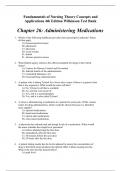Exam (elaborations)
Fundamentals of Nursing Theory Concepts and Applications 4th Edition Wilkinson Test Bank |Chapters 26-30|
- Course
- Institution
Chapter 26: Administering Medications Chapter 27: Nutrition Chapter 28: Urinary Elimination Chapter 29: Bowel Elimination Chapter 30: Sensation, Perception, & Response
[Show more]



